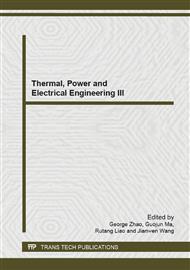[2]
myclobutanil belongs to mixed type inhibitor. The corrosion efficiency is calculated by the following formula [3]. icoor(inh) means the current density in the absence of myclobutanil. Fig. 2. Potentiodynamic polarization curves of copper in 1mol/L HCl solution with different concentrations of myclobutanil Table1 Potentiodynamic polarization parameters of copper in 1mol/L HCl solution with different concentrations of myclobutanil Concentration (mol/L) Ecorr (mV SCE) Icorr (μAcm-2) bc (mVdec-1) ba (mVdec-1) IE% blank -222.
Google Scholar
[75]
9 Electrochemical impedance spectroscope Fig. 3 shows the Nyquist diagram of copper electrode in the solution containing different concentrations of myclobutanil at 293K. Compared with the blank solution, the curves of the Nyquist diagrams with the myclobutanil shifted obviously and the impedance arc diameter get enlargement with increasing the concentration of myclobutanil. Fig. 4 shows the equivalent circuit of the electrochemical impedance spectroscopy. Rs represents the resistance of the solution, Rct is the charge transfer resistance, Rf stands for the film resistor, Cdl and Cf are double layer capacitance and film capacitor, respectively. W is the Warburg impedance which is caused by the diffusion of water soluble substances. Each element's data is in Table 2. The inhibition efficiency IE% with myclobutanil in different concentration is calculated by the following formula [4]: Fig. 3. Nyquist diagrams for copper in 1mol/L HCl solution with different concentrations of myclobutanil Fig. 2. Equivalent circuit model used to fit the EIS experiment data Table 2 Impedance parameters of copper in 1mol/L HCl solution with different concentrations of inhibitor at 293 K. Concentration (mol/L) Rs (Ωcm2) Rct (Ωcm2) Rf (Ωcm2) Cdl (μF/cm2) Cf (μF/cm2) W×1000 (S s0. 5cm-2) IE% Blank.
Google Scholar
[84]
3 Conclusion Myclobutanil is an effective inhibitor for corrosion of copper in acid medium at 293K. It can inhibit the copper corrosion by forming the adsorption protective film on metal surface [5]. The potentiodynamic polarization measurements showed that both cathodic and anodic processes of copper corrosion were suppressed and the myclobutanil acts as a mixed-type inhibitor. It is obviously that inhibition efficiency depended on inhibitor concentration and the corrosion efficiency reached the highest point at 3. 2×10-4 mol/L in 1mol/L HCl solution. Acknowledgments The authors gratefully acknowledge the support of Guangdong Innovative Research Team Program (NO. 2013C092) and the Open Foundation of State Key Laboratory of Electronic Thin Films and Integrated Devices (KFJJ201211), and we also express our sincere thanks to the support of Ph. D Programs Foundation of Ministry of Education of China, (No: 20120185110021). Refrences.
Google Scholar
[1]
H.O. Curkovic, E. Stupnisek-Lisac, H. Takenouti. Corros. Sci. Vol. 51(2009), pp.2342-2348.
DOI: 10.1016/j.corsci.2009.06.018
Google Scholar
[2]
Ying Yana, Weihua Li, Lankun Cai, Baorong Hou. Electrochimica Acta, Vol. 53 (2008), pp.5953-5960.
Google Scholar
[3]
Mohammed A. Amin, K.F. Khaled, Q. Mohsen, H.A. Arida, Corros. Sci. Vol. 52 (2010), pp.1684-1695.
Google Scholar
[4]
Mohammed.A. Amin, K.F. Khaled, Q. Mohsen, H.A. Arida, Corros. Sci. Vol. 52 (2010), p.1684–1695.
Google Scholar
[5]
S. Zhang, Z. Tao, W. Li, B. Hou, Appl. Surf. Sci. Vol. 255 (2009) , p.6757–6763.
Google Scholar


